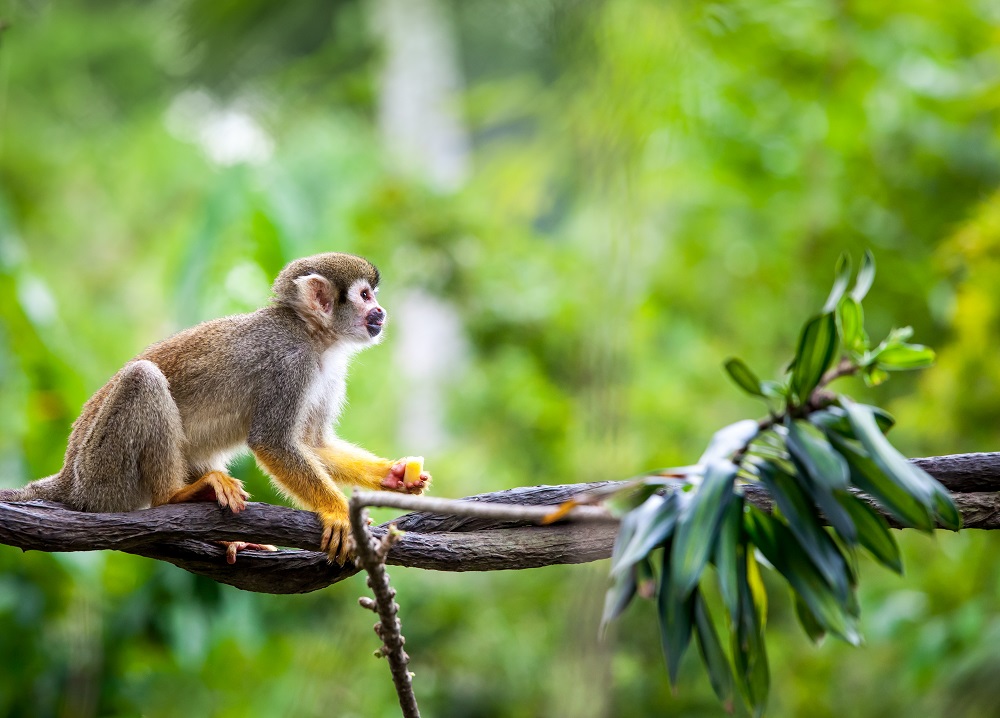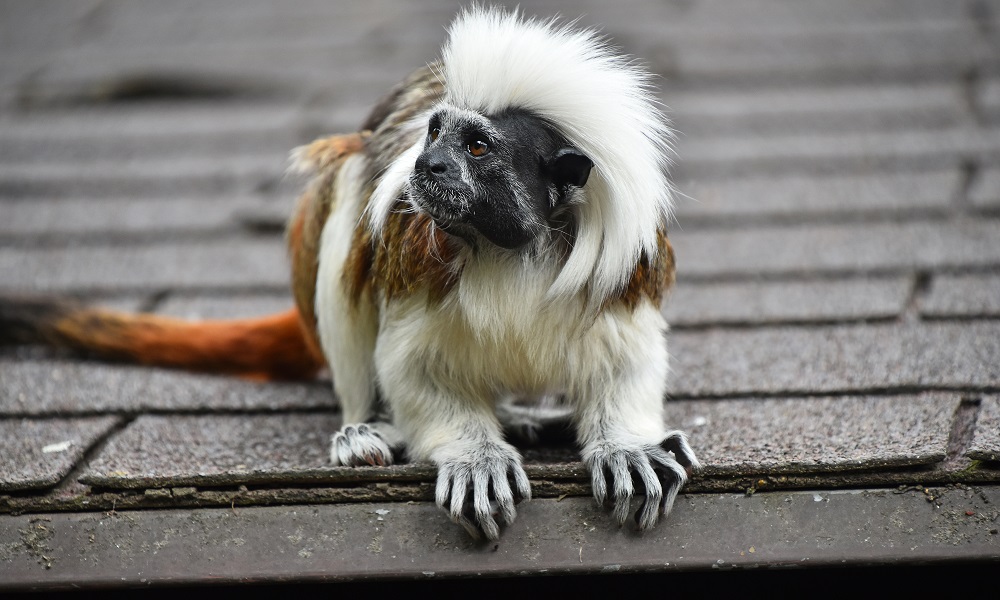These are the world’s tiniest monkey breeds to melt for!
Over time, monkeys have developed their agility to move through trees and jungle canopies at a lightning-fast pace. They are unlike any other animal on the planet, both in appearance and nature.
And we probably love them so much because they have a lot in common with us. But whenever we picture a monkey, we think of some of the worldwide-known breeds of chimps and gorillas. That’s why in this article, I decided to switch things up a bit and put together a list of the world’s tiniest monkey breeds.
We start with the biggest monkey species (16 inches long) and work our way down to the smallest (6 inches). The forests of Africa, Central America, South America, and Asia are home to all of them.

Squirrel Monkey
Isn’t it adorable? Squirrel monkeys are among the world’s tiniest monkey breeds and they’re so cute and smart you won’t believe it. These are small monkeys that live in groups of up to 500 in the forest canopy layer of Central and South America. They have yellow fur on their arms and tails and grey fur on most of their bodies.
Compared to other species from the list, these tiny ones can’t hold branches with their tail, instead, their tails serve only as a means of balance. It is believed that squirrel monkeys possess a large brain when compared to their body size, making them exceptionally intelligent.
Talapoin Monkey
The Talapoin Monkey is the biggest in the world’s tiniest monkey breeds because it measures only 16 inches long. It is found in central-western Africa, where it inhabits plantations, mangrove swamps, and rainforest trees, all of which it regularly raids for food.
They have a body length of 10 to 16 inches and a weight of 1.75 to 4.2 pounds, the most interesting fact about these monkeys is that their tail is as long as their bodies. The talapoin monkey follows the omnivore diet and enjoys munching on fruit, leaves, seeds, eggs, insects, and aquatic vegetation.
Sadly, this monkey only breeds once a year, and research indicates that Northern talapoin species are in danger of going extinct.
Dusky Titi
Dusky Titi monkeys have lifetime partners, as opposed to other tiny monkeys from the list. They choose a partner, develop a close relationship with them, and remain faithful to them until the end of life. Similar to humans, only these species are actually faithful to their partners (ahem).
These lazy monkeys reside near the Amazon River, in Brazil, usually feeding on plants, veggies, and fruits, but from time to time they also feast on insects. Since they are frequently spotted with their partner and children, you have a better chance of seeing the entire Titi family when you do see them! And usually, the one who carries the baby is the male.
Tarsiers
Cute with huge eyes and tiny hands, often mistaken with the sugar glider, tarsiers are among the world’s tiniest monkey breeds. They originate in Southeast Asia, specifically in the Philippines, Indonesia, Malaysia, and Brunei. They are 6 inches tall and weigh 5.8 ounces on average. And no, they can’t be kept as pets!

Cotton-top Tamarin
Adorable, fluffy, and pretty smart, the cotton-top tamarin is one of the world’s tiniest monkey breeds (10.2 inches long). Although their size would make them difficult to spot, their characteristic Albert Einstein-style hairstyle makes them easy to photograph, even though they blend in perfectly with the surroundings.
They live in the jungles of Colombia, or what’s left of them, and because of the deforestation that’s posing an increasing threat to their habitat, the Cotton-top Tamarin is listed as critically endangered. There are currently only about 6000 of them remaining.
Common Marmoset
Do you know what a marmoset looks like? I bet you do! Out of all the world’s tiniest monkey breeds, this one is by far the cutest and probably the most popular too. The tiny monkey known as the common marmoset has luscious, multicolored fur. It has lovely white ear tufts and a banded tail. On average, males measure 7.4 inches in length, while females measure 7.28 inches.
Like tamarins, they have claws or claw-like nails on their fingers and a proper nail on their thumb, which allows them to properly enjoy an active life in the wilderness. Recently, because of deforestation, they are starting to live in cities and towns close by, which is why they have become very popular among humans who also want to adopt them.
However, it’s illegal to own one because, despite their size and their cute little faces, once they mature, they might become aggressive.
Is your junior a fan of monkeys? I’ve got the perfect suggestion for you! Five Little Monkeys (Finger Puppet Board Book) is an adorable book that will help your kid find interesting things about monkeys, laugh, and spend some time with you. Spoiler: it gets addictive for adults too! Ha ha.
Silvery Marmoset
The silvery marmoset is another small monkey that measures up to 11 inches long, which, despite its size, is known as even more aggressive than the common marmoset. They are known to yell or frown at intruders due to their pointed jaws and somewhat sharp teeth. It also devours insects, fruits, and eggs.
They are found only in the eastern Amazon jungles, specifically in Brazil. Unlike other New World monkeys, which have nails on all their toes, these animals, except for their halluxes, have claws on all of their other toes.
Pygmy Marmoset
Is there something smaller than the common marmoset? Of course! The Pygmy Marmoset! The pygmy marmoset is thought to be the smallest monkey in the world (also known as the finger monkey), weighing 3.5 ounces and measuring an average of 5.1 inches.
This little monkey belongs to its own group called Cebuella and hangs out in the Amazon River basin. Its family groups consist of a male, a female, their children, and possibly an additional adult. They communicate with one another through visual displays, chemical secretions, and vocalizations.
The monkey can easily capture insects due to its small size. Similarly to other marmosets, the whole family helps raise the young. Separating one would not be in its best interests because they are also highly gregarious animals that flourish in their family group. Finally, even though they are intelligent beings, they can be a headache.
Can you keep a finger monkey as a pet?
While it might be tempting and cute, before keeping primates, especially monkeys, as pets, check your state’s legality. The private ownership of monkeys is either completely banned in more than half of the states and the District of Columbia, or it is allowed only under special licenses, permits, or exceptions granted by the state, county, or local government.
Because of their small size and adorable faces, these little marmosets became popular pets in the US, but you have to remember that they are still wild animals, though, and they might have savage instincts, and it won’t matter if you’re their owner or not. As they mature, finger monkeys, especially males, are known to be aggressive. When they are upset, they have been known to throw their feces, just like other monkeys.
Are you new to the page, but you’re on a roll with reading and discovering new things about the wildlife? You are in the right place for sure! So, before leaving and subscribing to our page (if you want to!) check out this article: 6 Longest Living Wildlife Animals on Earth.













One Response